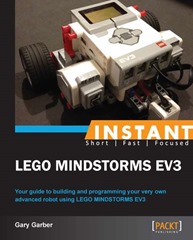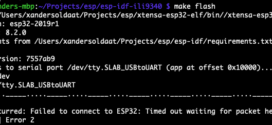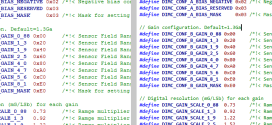 A little while ago, I was asked by Packt Publishing to review one of their new e-books called “Instant LEGO MINDSTORMS EV3” by Gary Garber. It’s a small (82 pages) e-book that is “A concise guide full of step-by-step recipes to teach you how to build and program an advanced robot.” It aims to be usable for both an experienced engineer and adult tinkerers that are not familiar with MINDSTORMS. This set requires you to have the LEGO EDUCATION version of the MINDSTORMS EV3 set.
A little while ago, I was asked by Packt Publishing to review one of their new e-books called “Instant LEGO MINDSTORMS EV3” by Gary Garber. It’s a small (82 pages) e-book that is “A concise guide full of step-by-step recipes to teach you how to build and program an advanced robot.” It aims to be usable for both an experienced engineer and adult tinkerers that are not familiar with MINDSTORMS. This set requires you to have the LEGO EDUCATION version of the MINDSTORMS EV3 set.
The book is split into four sections:
- Building a robot (Simple)
- Gyro sensor movement (Medium)
- Ultrasonic motion sensing (Advanced)
- Proportional line follower (Advanced)
Each section introduces a few new concepts and how you can use the robot’s abilities to perform certain tasks. The same basic model is used throughout but extra parts are added as needed.
This is not one of the best books I have ever read and I must say that I am a little disappointed with the overall quality of it. While I understand it’s a book to kickstart adults to be able to start dabbling with the EV3 platform, I can’t help but think that the book was rushed out the door a little too quickly.
Things I didn’t like about the book:
- There are issues with the consistency of the size of the icons in the screenshots, sometimes, on the same page, the icons can be of two different sizes, it’s distracting. This also applies to screenshots that are almost, but not completely the same size on the same page.
- Some of the screenshots are grainy, I had trouble reading some of the letters in the blocks. I assume this is because JPEGs were used instead of PNG, which uses a loss-less compression algorithm.
- Some of the renders of the models are done with a different quality level of rendering or maybe even with a different program, I am not sure.
- Some of the code has comments, other bits that could really use it, don’t.
- It would’ve been a lot better if the line follower had an auto-calibration sequence instead of a value that you need to tweak through a menu.
Some of the good things about this book:
- The model is nice and simple, it shouldn’t take long to get you up and going.
- The content is concise and to the point, although I am not sure Building Instructions (BI) need comments on what piece to put where, the BI itself should be sufficient. This would’ve saved page space, which could’ve been used to explain complex concepts like arrays a little more in-depth.
- The choice of using a line follower is a smart idea, they are very gratifying when they work.
- I like the “how it works”, “there’s more” and “getting ready” headers.
This may be quite a negative review but I feel that not enough time was spent to give this book the polished look and feel that it could’ve had. I understand that, given the number of pages, you cannot cover everything in depth, but that should not impact many of the points I have made above. Since it’s an e-book, it should be quite feasible to address these issues. Right now it looks more like a tutorial someone would put on their website, rather than something that would be sold for money.
 Bot Bench I'd Rather Be Building Robots
Bot Bench I'd Rather Be Building Robots



